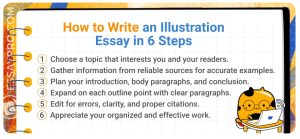How to Write an Illustration Essay in 6 Steps
How to Write an Illustration Essay in 6 Steps
Learning how to write an illustration essay can be straightforward and impactful by following these steps prepared by our essay writing service:

Step 1: Select a Topic
If you have the freedom to pick your topic, select one that you are genuinely interested in. Your enthusiasm for the subject will come through in your writing, making it more engaging for your readers. Think about subjects that you find intriguing or have a strong opinion about. This passion will help you stay motivated throughout the writing process and make the research feel less like a chore. Additionally, a topic that interests you will likely interest your readers as well, making your essay more impactful.
Step 2: Research
Before you start writing, gather ample information from reliable sources. Embrace research as your foundation; it’s essential for providing accurate and detailed examples in your essay. Use credible platforms such as Oxford Academic and Google Scholar to find scholarly articles, books, and other reputable sources. Take notes and organize your findings to easily reference them when writing your essay. Thorough research ensures that your examples are well-supported and enhances the credibility of your writing. The more comprehensive your research, the stronger your academic essay will be.
Step 3: Write an Outline
Creating an outline is a crucial step that helps organize your thoughts and structure your essay. Your outline should include an introductory paragraph, body paragraphs, and a conclusion.
Introduction: Start with an introduction that presents your topic, provides necessary background information, and states the significance of the topic. Conclude the introduction with a clear thesis statement that outlines the main idea of your essay.
Body Paragraphs: Plan each body paragraph to focus on a single example or idea that supports your thesis. Begin each paragraph with a topic sentence, followed by detailed examples and explanations. Use transitional phrases to ensure a smooth flow between paragraphs and maintain coherence throughout the essay.
Conclusion: Conclude your essay by restating the thesis in a new way, summarizing the main points discussed in the body paragraphs, and providing a final thought or statement that wraps up your essay.
Step 4: Write Your Ideas
With your outline in place, start writing your essay by expanding on each point. Transform your main ideas into full paragraphs, making sure each paragraph clearly presents one example and supports it with detailed evidence. Write in a clear and concise manner, avoiding unnecessary jargon or overly complex sentences. Each paragraph should build on the previous one, creating a cohesive and logically organized essay. Make sure your writing is engaging and that your examples effectively illustrate your points.
Step 5: Review
After completing your essay, take the time to review and edit it thoroughly. Read through your essay at least twice to catch any grammatical, structural, or contextual errors. Check that your examples are clear and well-supported, and ensure that your essay flows logically from one point to the next. Make sure your writing is free of plagiarism by properly citing all sources. Editing is a crucial step that can greatly improve the clarity and quality of your essay, so don’t rush this process.
Step 6: Enjoy Your Perfect Essay
By following these steps, you should have a well-organized and effective illustration essay. Take a moment to appreciate your hard work and the finished product. Remember, writing can be a smooth and rewarding process when you approach it methodically and with attention to detail.
Illustration Essay Outline
Before starting your illustrative essay, it’s essential to prepare an outline. A simple way to do this is to write a 5-sentence outline, with each sentence briefly describing the focus of each paragraph. This will help you organize your main ideas and develop them further.
Here are the key parts your illustration essay outline should include:
Section 📋 Details 📝
Introduction 🌟
1-2 sentences introducing the topic and providing background information.
1-2 sentences explaining the relevance and importance of the topic.
A strong thesis statement giving a brief overview of the essay.
Body Paragraphs (usually 3) 📝
1 transitional sentence to lead into the body paragraphs.
Each paragraph presents one main idea.
Include a demonstrative example to support each idea.
1 linking sentence to connect ideas smoothly.
Conclusion 🔚
1 sentence restating the thesis statement.
A brief summary of the main ideas discussed.
1-2 concluding sentences to wrap up the essay.
Illustration Essay Topics
When beginning the writing process, choosing a compelling topic is the first step. Here is a list of illustration essay topics to inspire you. Feel free to select one from the list to craft an engaging and informative illustration essay.
Illustrate the daily routine of a remote worker and the challenges they face.
Describe the process of training a service dog and its impact on individuals with disabilities.
Explain the benefits of mindfulness meditation for reducing stress and improving mental health.
Detail the steps involved in organizing a successful community clean-up event.
Illustrate the effects of a balanced diet on overall health and well-being.
Explain how a public library can serve as a community hub and support lifelong learning.
Describe the process of starting a small business and the challenges entrepreneurs encounter.
Illustrate the importance of voting in local elections and how it impacts the community.
Explain the role of social workers in supporting vulnerable populations and provide examples from real-life scenarios.
Detail the impact of volunteer work on both the volunteers and the community they serve.
Illustration Essay Example
Looking at our well-written illustration essay example can help you understand this writing style better. Use the clear example below to improve your own writing skills.
Digital Age
Small Business
We also recommend taking a look at our comprehensive guide on a narrative essay, complete with examples.
Source:
